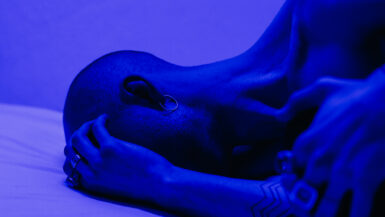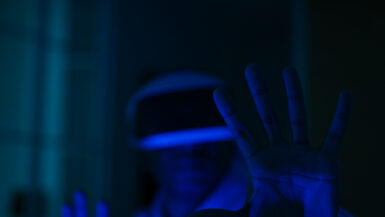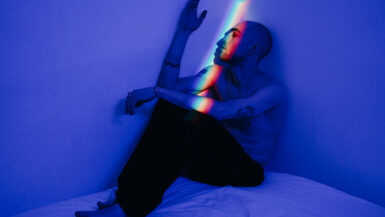In today’s fast-paced, technology-driven world, the effect of blue light exposure on our sleep and productivity has become a significant area of interest and concern. As we continuously surround ourselves with electronic devices emitting this high-energy visible (HEV) light, it is essential to understand how blue light impacts our natural sleep cycle, particularly the rapid eye movement (REM) phase, and how it influences our ability to dream. In this comprehensive article, we delve into the science behind blue light exposure, its effects on REM sleep, the role it plays in our dreaming, and how it ultimately impacts our overall productivity. By raising awareness of this critical issue, we aim to provide valuable insights and practical strategies for striking a healthy balance between modern technology use and our well-being.
How Screen Time Impacts Productivity and Alertness
As we progress through the digital age, screen time has become an integral part of our daily lives. The constant exposure to electronic devices has raised concerns regarding its effects on our productivity and alertness, particularly since blue light emissions play a significant role in these aspects. In this section, we will discuss the relationship between screen time and productivity, and how it influences our alertness levels throughout the day.
The Science Behind Blue Light and Its Effects on Our Circadian Rhythm
Blue light, a component of the visible light spectrum, has a wavelength of approximately 380 to 500 nanometers. It has the unique ability to influence our circadian rhythm, the internal clock that regulates our sleep-wake cycle. Exposure to blue light during daytime hours can have a positive effect, as it boosts alertness and cognitive function. However, excessive exposure to blue light, particularly in the evening, can disrupt our natural sleep pattern, making it difficult to fall asleep and stay asleep.
Negative Impact of Excessive Screen Time on Productivity
While blue light exposure during the day can enhance productivity, too much screen time, especially before bedtime, can lead to adverse effects on our ability to focus and accomplish tasks efficiently. Studies have shown an increase in sleep disturbances and insomnia among individuals who spend extended periods using electronic devices. This lack of quality sleep can result in reduced cognitive function, impaired decision-making, and decreased overall productivity.
Alertness, Sleep Quality, and the Role of Electronics
Our daily alertness levels are significantly influenced by the quality of sleep we receive each night. Poor sleep quality, often resulting from excessive blue light exposure, can lead to drowsiness and reduced alertness during the day. This can further impact our ability to concentrate, make decisions, and stay vigilant, ultimately affecting both our personal and professional lives.
Striking a Balance: Tips for Minimizing Blue Light Exposure Before Bedtime
To mitigate the negative effects of blue light exposure on sleep quality and productivity, it is essential to strike a balance between our screen time and sleep hygiene. Incorporating certain habits and practices, such as reducing screen time before bedtime and utilizing blue light filtering apps, can significantly improve sleep quality and overall productivity. For more tips and strategies to minimize blue light exposure before bedtime, visit “Tips to Minimize Blue Light Exposure Before Bedtime“.
Understanding the impact of blue light on our sleep and productivity is crucial in today’s technology-driven world. By being mindful of our screen time and implementing strategies to minimize blue light exposure, we can protect our sleep quality, improve our alertness, and enhance our overall productivity.
Blue Light Blocking Solutions for Better Sleep and Work Performance
In order to counter the negative effects of blue light exposure on our sleep and work performance, several blue light blocking solutions have been developed. These solutions can help reduce the impact of blue light on our sleep patterns, promote more restful sleep, and ultimately contribute to improved productivity and overall well-being. In this subsection, we explore various blue light blocking tools and strategies, providing insights into their effectiveness and practicality for everyday use.
Blue Light Filtering Software and Applications
One of the most accessible and convenient ways to reduce blue light exposure is through the use of software and applications designed to filter out blue light emissions from our electronic devices. Apps such as f.lux and Night Shift (for iOS devices) can automatically adjust the color temperature of your screen to warmer hues, effectively reducing blue light emissions. By installing and utilizing these tools, users can experience better sleep quality and improved work performance.
Blue Light Blocking Glasses
Another popular solution for mitigating blue light exposure is the use of blue light blocking glasses. These specially designed eyeglasses feature lenses that filter out a significant portion of blue light emitted by screens, allowing for reduced eye strain and improved sleep quality. By wearing blue light blocking glasses while using electronic devices, especially in the evening, users can minimize disruptions to their natural sleep cycles and maintain higher levels of productivity.
Electronic Device Settings and Usage Habits
In addition to software and glasses, individuals can take steps to reduce blue light exposure by adjusting the settings on their electronic devices and modifying their screen usage habits. For example, many devices offer built-in settings that allow users to adjust the color temperature or enable a nighttime mode that reduces blue light emissions. Furthermore, limiting screen time in the evening and establishing a consistent bedtime routine can help promote better sleep and overall well-being.
Creating a Sleep-Friendly Environment
Finally, creating a sleep-friendly environment can further enhance the effectiveness of blue light blocking solutions. This may involve the use of dimmable lights with warmer color temperatures, blackout curtains, or even investing in a high-quality sleep mask. By cultivating a relaxing and sleep-conducive space, individuals can improve their chances of achieving restful and rejuvenating sleep, ultimately leading to better work performance and overall health.
Implementing these blue light blocking solutions can significantly reduce the impact of blue light on our sleep and work performance. By adopting these strategies and tools, we can enjoy the benefits of modern technology without compromising our sleep quality, productivity, and overall well-being.
Understanding Blue Light Exposure and Sleep Cycles
In order to fully comprehend the effects of blue light on REM sleep and dreaming, it is crucial to delve into the relationship between blue light exposure and our natural sleep cycles. This subsection will explore the role of blue light in regulating our circadian rhythm, the impact of exposure on different stages of sleep, and how this ultimately influences the quality of our dreams.
The Role of Blue Light in Regulating Our Circadian Rhythm
Our circadian rhythm is the internal clock that governs our sleep-wake cycle and is significantly influenced by exposure to light, particularly blue light. During the day, exposure to natural sunlight, which contains blue light, helps maintain our alertness and cognitive function. However, as the sun sets and our environment becomes darker, this decrease in blue light exposure signals our brain to produce melatonin, the hormone responsible for inducing sleepiness. Consequently, the artificial blue light emitted by electronic devices can disrupt this natural process, leading to difficulties falling asleep and staying asleep.
Stages of Sleep and the Impact of Blue Light Exposure
Sleep can be divided into several stages, including non-rapid eye movement (NREM) sleep and rapid eye movement (REM) sleep. NREM sleep is further categorized into three stages (N1, N2, and N3), with each stage representing a progressively deeper level of sleep. REM sleep, on the other hand, is characterized by rapid eye movements, vivid dreams, and increased brain activity. The disruption of our circadian rhythm by blue light exposure can lead to difficulties transitioning between these stages of sleep, potentially reducing the overall duration of REM sleep and affecting the quality of our dreams.
Blue Light’s Influence on REM Sleep and Dreaming
As previously mentioned, blue light exposure can cause disruptions in our sleep cycles, particularly affecting the REM sleep stage. Studies have shown that reduced REM sleep can result in fragmented and less vivid dreams, as well as a decreased ability to consolidate memories. This can lead to negative consequences for our mental and emotional well-being, as REM sleep is believed to play an essential role in processing emotions and maintaining psychological balance.
Strategies for Protecting REM Sleep and Dream Quality
To safeguard our REM sleep and dream quality, it is essential to limit exposure to blue light before bedtime. This can be achieved through the use of blue light filtering applications, adjusting device settings, and cultivating a sleep-friendly environment, as discussed in previous subsections. By implementing these strategies, individuals can experience more restorative sleep, richer dreams, and improved emotional and cognitive well-being.
In summary, understanding the relationship between blue light exposure and our natural sleep cycles is crucial for preserving the quality of our REM sleep and dreams. By being mindful of our electronic device usage, especially in the evening, we can promote healthier sleep patterns and reap the benefits of more restful and rejuvenating sleep.
Blue Light’s Effect on REM Sleep and Dream Quality
In an era where electronic devices have become an integral part of our daily lives, it is crucial to understand how blue light, emitted by these devices, can impact our REM sleep and dream quality. This subsection delves into the intricacies of how blue light affects our sleep patterns, with a particular focus on its influence on the REM sleep stage and the quality of our dreams.
Disrupting Circadian Rhythm and REM Sleep Patterns
Blue light exposure, especially in the evening, can interfere with our natural circadian rhythm, the internal clock that governs our sleep-wake cycle. When our circadian rhythm is disrupted, it can lead to difficulty falling asleep and staying asleep, as well as affect the duration and quality of our REM sleep. This disturbance in our sleep patterns can adversely impact the restorative aspects of REM sleep, including memory consolidation, emotional processing, and cognitive function.
Fragmented Dreams and Reduced Dream Vividness
Research has shown that reduced REM sleep duration, resulting from excessive blue light exposure, can lead to fragmented and less vivid dreams. This diminished dream quality can hinder our ability to process and make sense of our emotions, as well as impact our creative thinking and problem-solving abilities. As a result, the quality of our waking lives may be negatively affected, potentially leading to decreased overall well-being.
Impairment of Emotional and Cognitive Well-Being
The disruption of REM sleep and the subsequent impact on dream quality can have far-reaching consequences for our emotional and cognitive well-being. REM sleep is believed to play a critical role in processing emotions, coping with stress, and maintaining psychological balance. Therefore, when blue light exposure interferes with this vital sleep stage, our ability to effectively manage our emotions and maintain optimal mental health may be compromised.
Strategies for Minimizing Blue Light’s Impact on REM Sleep and Dreams
To counter the negative effects of blue light exposure on REM sleep and dream quality, it is essential to adopt strategies that minimize blue light exposure, especially during the hours leading up to bedtime. These strategies may include using blue light filtering apps, wearing blue light blocking glasses, adjusting device settings, and cultivating a sleep-friendly environment. By taking proactive measures to reduce blue light exposure, we can work towards protecting our REM sleep, enhancing dream quality, and promoting overall mental and emotional well-being.
It is evident that understanding the relationship between blue light exposure and its influence on REM sleep and dream quality is of utmost importance in our technology-driven world. By being aware of the potential consequences and taking steps to minimize blue light exposure, we can strive to preserve the restorative aspects of REM sleep, ultimately leading to improved emotional, cognitive, and overall well-being.
Natural Ways to Reduce Blue Light Exposure Before Bedtime
As we have discussed the impact of blue light on REM sleep and dreaming, it is vital to explore natural ways to minimize blue light exposure before bedtime. These strategies can help protect our sleep quality, preserve the restorative aspects of REM sleep, and contribute to overall well-being. In this subsection, we will delve into various natural methods for reducing blue light exposure, providing practical and easy-to-implement tips to promote better sleep and dreaming.
Embrace the Twilight Hour
Making a conscious effort to dim the lights and reduce screen time during the twilight hour – the period just before sunset – can help signal to your body that it is time to wind down and prepare for sleep. This practice assists in the natural production of melatonin, the sleep hormone, which can be disrupted by artificial blue light exposure.
Opt for Warm Lighting in Your Home
Switching to light bulbs with warmer color temperatures can help reduce blue light exposure in your living space. Look for bulbs with a color temperature of 2700K or lower, as these emit less blue light than their cooler counterparts. This simple change can create a more sleep-friendly environment and support a healthy circadian rhythm.
Establish a Relaxing Bedtime Routine
Creating a consistent bedtime routine that promotes relaxation and minimizes blue light exposure can greatly improve sleep quality. Consider activities such as reading a physical book, practicing meditation, or engaging in gentle stretches, all of which can help calm the mind and prepare the body for restful sleep.
Make Use of Natural Light During the Day
Exposure to natural sunlight during the day can help regulate your circadian rhythm and improve sleep quality at night. Aim to spend time outside during daylight hours, or open your curtains and blinds to let in as much natural light as possible. Not only does this help maintain healthy sleep patterns, but it also provides valuable health benefits from exposure to sunlight, such as vitamin D production.
Opt for Screen-Free Activities in the Evening
Choosing screen-free activities in the evening can significantly reduce your blue light exposure before bedtime. Consider engaging in hobbies such as knitting, drawing, or playing a musical instrument, which not only minimize blue light exposure but also promote relaxation and creativity.
By adopting these natural strategies for reducing blue light exposure before bedtime, you can effectively protect your REM sleep and dream quality, promoting better sleep and overall well-being. Incorporating these habits into your daily routine can lead to a more balanced lifestyle, allowing you to enjoy the benefits of modern technology without compromising your sleep health.





Leave a reply